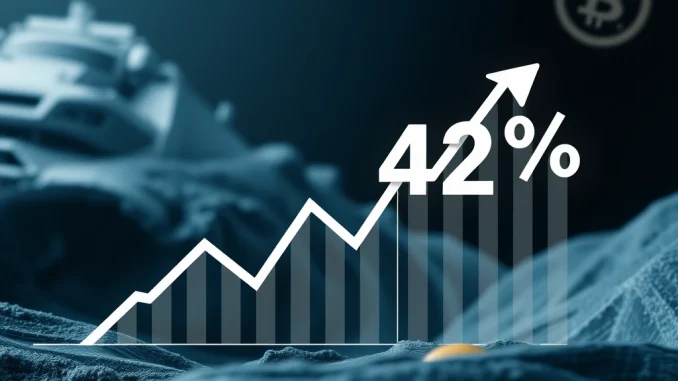
Leading digital asset manager, CoinShares, recently released its financial results for the first quarter, revealing a significant dip in profitability. The report highlights how broader economic forces continue to shape the performance of companies operating within the cryptocurrency space. Let’s break down what these numbers mean for CoinShares and the wider crypto asset management industry.
What Happened with CoinShares Q1 Profit?
According to reports, CoinShares posted a net profit of $24 million for the first quarter. While still a substantial figure, this represents a notable decrease compared to the same period in the previous year.
Key figures from the CoinShares Q1 report:
- **Q1 Net Profit:** $24 million
- **Year-on-Year Change:** Down 42.2%
This decline indicates that despite ongoing activity in the digital asset market, the operating environment has become considerably more challenging for firms like CoinShares.
Why Did Profitability Fall for This Digital Asset Manager?
CoinShares attributed the decline in profits primarily to “macroeconomic headwinds” encountered during the quarter. What exactly does this mean in the context of digital assets?
Macroeconomic factors influencing the crypto market performance during the period likely included:
- **Rising Interest Rates:** Central banks globally increased rates to combat inflation, making riskier assets like cryptocurrencies less attractive compared to traditional investments.
- **Inflation Concerns:** Persistent inflation eroded purchasing power and led to cautious investor sentiment.
- **Geopolitical Instability:** Global events added layers of uncertainty to financial markets, impacting investor confidence.
- **General Market Downturn:** These factors contributed to a broader decline across equity and bond markets, which often correlates with downward trends in digital assets.
For a digital asset manager, these conditions translate directly into challenges such as reduced assets under management (AUM), lower trading volumes, and potentially compressed fee income, all of which impact the bottom line.
How Do Macro Headwinds Impact Crypto Asset Management?
Companies specializing in crypto asset management generate revenue primarily through fees based on the value of assets they manage and potentially from trading activities or other related services. When the overall value of the digital asset market declines due to macroeconomic pressures, it directly affects their revenue streams.
Consider the flow:
- Macroeconomic factors create market uncertainty.
- Investors become risk-averse, leading to outflows or reduced inflows into digital asset products.
- The price of underlying digital assets (like Bitcoin and Ethereum) falls.
- Assets Under Management (AUM) for firms like CoinShares decrease.
- Revenue, often calculated as a percentage of AUM, declines.
- Profitability is squeezed due to lower revenue against relatively stable operating costs.
This cycle explains how external economic forces can significantly impact the financial health of even established players in the crypto asset management sector.
What Does This Tell Us About Crypto Market Performance?
CoinShares’ results serve as a tangible indicator of the prevailing conditions in the digital asset market during the first quarter. The 42% profit drop is a clear signal that the period was challenging, reflecting the broader downturn and reduced investor activity that characterized the market at that time.
While individual company performance can vary, the results from a major digital asset manager like CoinShares offer insights into:
- The sensitivity of the crypto market to global economic conditions.
- The impact of reduced liquidity and trading volume.
- The pressure on business models reliant on market appreciation and trading activity.
It underscores that the crypto market performance is not isolated but is increasingly intertwined with traditional finance and global economic trends.
Looking Ahead: Challenges and Resilience
The Q1 results highlight the challenges faced by digital asset companies during bear market cycles. However, they also prompt questions about resilience and adaptation.
Actionable insights for observers and market participants:
- **Monitor Macro Trends:** Pay close attention to global economic indicators like inflation, interest rates, and central bank policies, as they have a clear impact on digital assets.
- **Evaluate Business Models:** Assess how different companies in the crypto space are structured to withstand downturns – are they overly reliant on AUM fees, or do they have diversified revenue streams?
- **Observe Investor Behavior:** Track flows into and out of regulated digital asset products as an indicator of institutional and sophisticated investor sentiment.
Companies like CoinShares must navigate these difficult periods by potentially diversifying services, managing costs, and preparing for future market upturns.
Summary
CoinShares’ report of a 42.2% drop in Q1 net profit to $24 million underscores the significant impact of macroeconomic headwinds on the crypto asset management industry. As a leading digital asset manager, CoinShares’ CoinShares Q1 financial performance provides a clear picture of the challenges posed by a difficult market environment marked by rising rates and economic uncertainty. These results reflect the broader conditions impacting crypto market performance and highlight the need for resilience and strategic adaptation within the sector.



